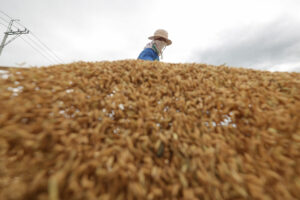THE GOVERNMENT needs to hike the selling price for locally produced palay or unmilled rice to increase local rice production, an analyst said.
“The farmer needs to earn… They would no longer aspire to yield five metric tons (MT) per hectare if palay prices were at P15 to P16 per kilogram,” Teodoro C. Mendoza, an agronomist and a retired professor at the University of the Philippines Los Baños, told BusinessWorld in a phone call.
In April, the National Food Authority (NFA) had set a price of P23 to P30 per kilo for dry and clean palay, and P17 to P23 per kilo for fresh palay. Agriculture Secretary Francisco P. Tiu Laurel, Jr. has said the selling price for the NFA during the wet season harvest would be set at P23 per kilo for dry palay and P20 per kilo for wet palay.
In July, the farmgate price for palay was at P24.47 per kilo, 19.07% higher than the P22.08 per kilo price in the same month last year, according to the Philippine Statistics Authority (PSA).
Mr. Mendoza said palay prices may further decline during the harvest months of November and December.
He noted farmers yielding five MT per hectare need to make about P50,000 per hectare to keep profit up amid higher input costs.
The current national average yield for palay is 4.17 MT per hectare, equivalent to 84 bags weighing 50 kilograms, according to the Department of Agriculture (DA).
“What we want is to raise the selling price of rice which is essentially the price received by the farmers. But this is a function of the market. The government is not supposed to intervene unless there is a market failure,” Ateneo de Manila University economics professor Leonardo A. Lanzona said in a Facebook Messenger chat.
Philippine Rice Research Institute (PhilRice) Deputy Executive Director Flordeliza H. Bordey said the seeds distributed by the government to farmers are not fully resistant to adverse weather conditions.
“Nothing is really resistant to typhoons. As much as possible, we are trying to improve varieties that have a better probability of surviving if they are flooded, or droughts during El Niño,” she said in an interview with reporters last week.
The state weather service had said earlier that there is a 70% likelihood for La Niña to occur during the months of August to December, bringing in a higher chance of tropical cyclone activity.
One of the programs of PhilRice is the development of better seed varieties to be used to increase local rice production. It distributes an average of 3.3 million 20-kilo bags of certified inbred seeds to about 1.5 million farmers each year, funded by the Rice Competitiveness Enhancement Fund.
Ms. Bordey said that the seed distributed by PhilRice can improve the yields of farmers.
“We are doing our best to help our farmers to have a fighting chance. But agriculture is really very weather dependent, and the full effect of calamities cannot yet be determined until they are already there,” Ms. Bordey added.
Ms. Bordey said this year’s palay production may likely be unchanged from the 20.06 million MT harvest last year.
“It is possible that there would be more calamities for the rest of the year, then we may not be able to (increase productions). But we are hoping to get the same as last year, which is a good scenario that we are seeking,” she added.
Palay production fell by 5% to 8.53 million MT as of the first semester from 9.03 million MT, PSA data showed. This was mainly attributed to the dry conditions brought by the El Niño phenomenon.
“The decline is not that (major), it only affected rice crops that were planted late. We are not sure yet if production will decline this year; hopefully there will be no major storms entering the country during the harvest time,” Mr. Mendoza said.
Earlier, the DA had revised its palay production estimates to about 20.1 million MT this year due to the dry conditions brought by El Niño and the possible effects of storms due to the incoming La Niña. The latest estimate represents a downgrade of an earlier DA projection of 20.44 million MT. — Adrian H. Halili
